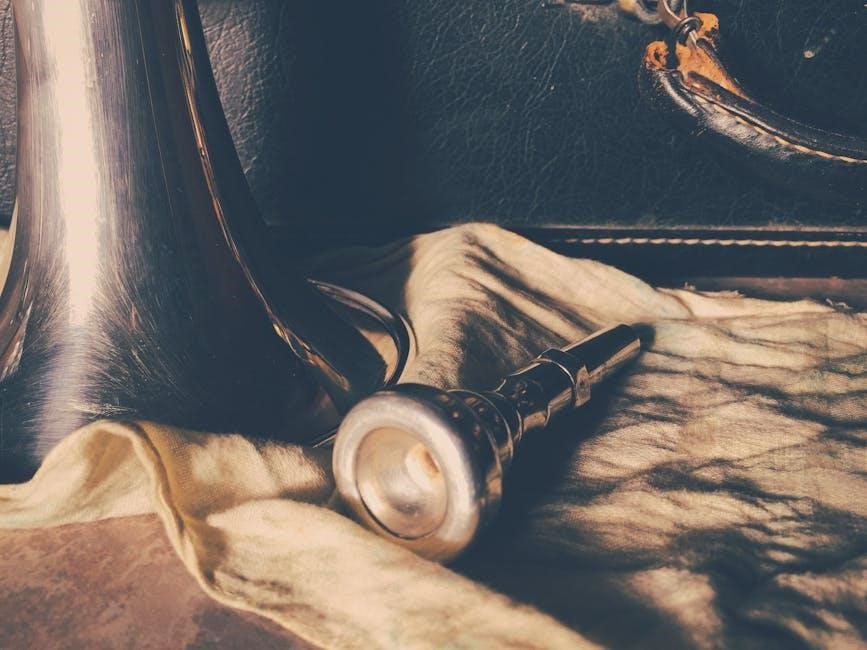Before choosing a mouthpiece, understanding its parts is essential․ The cup, the concave part against your lips, significantly affects tone․ The rim, which is the edge that contacts your lips, impacts comfort and endurance․

Understanding Trumpet Mouthpiece Basics
Components of a Trumpet Mouthpiece
A trumpet mouthpiece consists of several key parts, each influencing sound and playability․ First, the cup, its depth and shape greatly affect the tone․ A deeper cup often creates a darker, richer sound․ Then, there’s the rim, the part that touches your lips․ Rim feel can greatly impact comfort and endurance․ The throat is the opening at the bottom of the cup, influencing resistance and airflow․ Lastly, the backbore shapes the sound further and affects intonation․ Each part contributes uniquely to the overall playing experience and response of the instrument․
Selecting a mouthpiece can be overwhelming, but experimenting is key․ Try various cup depths to find what suits you best․ Different combinations are important in finding the perfect fit for you․
Choosing the Right Trumpet Mouthpiece
Experimenting with Different Cup Depths
When choosing a trumpet mouthpiece, experimenting with different cup depths is crucial for finding the right fit․ The cup depth significantly affects the tone and playability of the trumpet; A deeper cup generally produces a darker, richer tone, while a shallower cup tends to create a brighter, more brilliant sound․
By trying out mouthpieces with varying cup depths, players can discover which one allows them to achieve their desired tone and range․ Experimentation is key to optimizing performance and maximizing enjoyment while playing the trumpet․ So, be open to try different options․
Each manufacturer uses its unique numbering system for mouthpieces․ Numbers indicate cup size, rim shape, and sometimes throat and backbore sizes․ Understanding these systems is crucial for informed selection․

Trumpet Mouthpiece Numbering Systems
Manufacturer Variations
Navigating trumpet mouthpiece numbering can be tricky due to manufacturer variations․ Each brand employs a unique system, making direct comparisons challenging․ For example, a “7” from one company might not equal a “7” from another in terms of rim diameter․ Similarly, cup depths labeled “C” may differ across brands․ These variations extend to the throat and backbore dimensions, adding to the complexity․ Players should research each manufacturer’s specifications or consult with experienced players and music stores to understand the nuances of each numbering system․ This ensures proper mouthpiece selection․
Trumpet Mouthpiece Selection for Beginners
Beginner Trumpet Mouthpieces or What is a 7C Trumpet Mouthpiece?
Starting trumpet? The 7C mouthpiece is common․ The ‘7’ refers to the rim diameter, and ‘C’ denotes the cup depth․ Many beginners start with this mouthpiece because it offers a balanced playing experience․
Beginner Trumpet Mouthpieces or What is a 7C Trumpet Mouthpiece?
If you are just beginning to play the trumpet, this section is for you․ The most common trumpet mouthpiece that beginners usually start with is the 7C․ The 7 refers to the rim diameter, and the C indicates the cup size․ However, the numbers might not always make perfect sense․ Many instrument manufacturers include mouthpieces with their trumpets, often under their own brand․
For beginner trumpet and cornet players, the endless quest for the “perfect” mouthpiece isn’t necessary․ Younger players should focus on developing fundamental skills rather than obsessing over mouthpiece selection immediately․

Impact of Mouthpiece on Playing
Trumpet mouthpiece selection significantly impacts playing, influencing tone, range, flexibility, accuracy, endurance, tuning, and intonation․ Choosing the right mouthpiece can improve all these aspects of your playing․
Tone, Range, Flexibility, Accuracy, Endurance, Tuning and Intonation
A mouthpiece impacts several crucial playing elements․ Tone can become brighter or darker based on the cup shape․ Range might expand or contract, depending on the cup depth and backbore․ Flexibility, the ease of moving between notes, is also affected by the mouthpiece․ Accuracy in hitting notes cleanly and the overall endurance during long performances can be improved․ Finally, the mouthpiece influences tuning and intonation, ensuring notes are in tune across the instrument’s range․ Selecting the right mouthpiece is vital for optimizing these factors․
While important, rim feel should not be the primary selection criterion․ Many players select a mouthpiece size because the rim feels good, but there are more important criteria, such as cup size․
Factors to Consider When Choosing a Mouthpiece
Rim Feel
Rim feel is a crucial factor when selecting a trumpet mouthpiece, but it should not be the only consideration․ Many players prioritize how the rim feels against their lips, as comfort plays a significant role in endurance and overall playing experience․ A rim that feels too sharp or too round can lead to discomfort and fatigue, hindering performance․ While a comfortable rim is essential, it’s important to balance this with other factors like cup depth, throat size, and backbore to achieve the desired tone and playability․
Trumpet Mouthpiece Cup Size
A bigger cup size generally allows for a bigger sound and more room for tonguing․ Some recommend starting with a larger mouthpiece, like a 3C, to develop a fuller tone from the beginning․
Bigger Cup Size Advantages
Opting for a trumpet mouthpiece with a larger cup offers several potential benefits, primarily related to the tonal quality and ease of articulation․ Many players find that a bigger cup facilitates the production of a broader, more resonant sound․ The increased volume within the cup provides more space for the air column to vibrate, contributing to a richer and fuller tone, especially in the lower register․
Furthermore, a larger cup can offer increased room for tonguing․ The additional space allows for greater freedom of movement, potentially leading to improved clarity and precision in articulation․ This can be particularly advantageous for players who prioritize a clear and defined attack;
Experimenting with throat sizes is important․ If a student wants to experiment with throat sizes, I recommend finding an old mouthpiece to try it out prior to making the permanent adjustment on a mouthpiece․

Trumpet Mouthpiece Throat Sizes
Experimenting with Throat Sizes
If a student wants to experiment with throat sizes, I recommend finding an old mouthpiece to try it out prior to making the permanent adjustment on a mouthpiece․ The throat of a trumpet mouthpiece is the opening at the bottom of the cup that leads into the backbore․ It significantly impacts the horn’s resistance and tone․ A wider throat allows for more airflow, potentially resulting in a bigger, more open sound․ However, it can also make the trumpet harder to control, especially in the upper register․ Conversely, a narrower throat offers more resistance, making high notes easier to hit but potentially sacrificing tonal breadth․
Seek guidance from music stores for mouthpiece selection․ Staff can guide you to mouthpieces you might like․ Music stores offer the advantage of trying mouthpieces before buying, ensuring a good fit․
Where to Buy Trumpet Mouthpieces
Guidance from Music Stores
Visiting a local music store is a great way to start your mouthpiece search․ Knowledgeable staff can offer personalized recommendations based on your playing level and preferences․ They often allow you to try different mouthpieces, a crucial step in finding the perfect fit․ Take advantage of their expertise to explore various brands, sizes, and materials․ Don’t hesitate to ask questions about the impact of different mouthpiece features on your tone and playing style․ This hands-on approach ensures you make an informed decision and select a mouthpiece that enhances your performance․
Maintaining your trumpet mouthpiece is crucial for hygiene․ Regular cleaning prevents bacteria buildup․ This helps ensure a healthy and enjoyable playing experience․ Simple cleaning routines extend the life of your mouthpiece․
Trumpet Mouthpiece Maintenance
Hygiene
Maintaining proper hygiene for your trumpet mouthpiece is paramount for several reasons, primarily to prevent the accumulation of bacteria and fungi․ Regular cleaning helps eliminate residual saliva and debris, which can foster microbial growth․ Neglecting this aspect can lead to unpleasant odors, corrosion of the mouthpiece material, and potential health risks․
A simple routine involves rinsing the mouthpiece with warm water after each playing session․ Periodically, it’s advisable to use a specialized mouthpiece cleaning solution or mild soap and water, ensuring thorough rinsing to remove any remaining cleaning agents․ This helps maintain a clean and healthy instrument․
Bill Adam suggests buzzing the leadpipe to gently warm up the embouchure․ The goal is relaxed airflow․ This prepares the lips for playing, enhancing tone and control, and is a beneficial practice․
Trumpet Warm-up Exercises
Buzzing the Leadpipe
Buzzing the leadpipe is a trumpet warm-up technique where you buzz your lips directly into the trumpet’s leadpipe (the part where the mouthpiece goes)․ This exercise, recommended by Bill Adam, helps to focus on proper embouchure formation and breath control without the added resistance of the entire instrument․ It encourages a relaxed approach to playing․ The aim is to achieve a consistent, clear buzz, promoting blood flow and flexibility in the lip muscles․ This ultimately leads to improved tone and responsiveness on the trumpet․ Focus on maintaining a steady airflow and avoiding excessive pressure․
When forming the playing position, the tip and oral cavity shape influence sound․ The space from the larynx to the lip aperture affects embouchure and should be considered for mouthpiece selection․
Embouchure and Mouthpiece Selection
The player must bear in mind the gradually narrowing space in the mouth cavity, from the larynx to the lip aperture․
When forming the playing position, the tip and oral cavity shape influence sound production․ The player must consider the gradually narrowing space in the mouth, from the larynx to the lip aperture․ This constriction significantly affects embouchure and should be considered for mouthpiece selection․ The oral cavity’s shape and the tongue’s position play crucial roles in directing airflow and shaping the tone․ A well-chosen mouthpiece complements the player’s natural embouchure, facilitating efficient air usage, improved tone quality, and enhanced control over the instrument․ Considering these factors optimizes playing comfort and performance․
